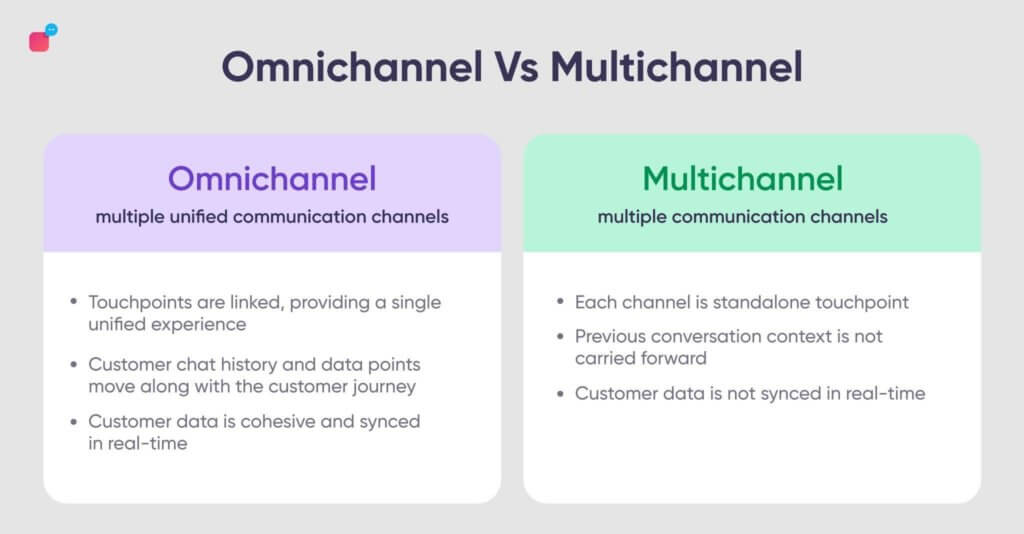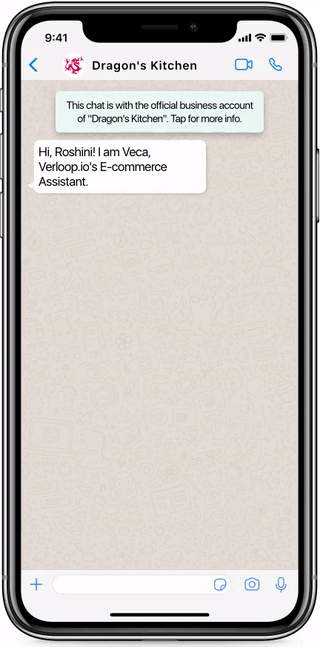What is Omnichannel Customer Support?

What is Omnichannel Customer Support?
Omnichannel support integrates multiple customer engagement channels to provide a seamless customer experience. Let’s look at the whats, hows and best practices of omnichannel support.
Customers are using multiple channels to communicate with your brand. They use mobile apps, websites, email, social media channels such as Facebook, Twitter and Instagram, and messaging platforms such as WhatsApp. To provide a good customer experience, your company needs to take one step further and provide them with omnichannel customer support.
With technological advances, the world is moving towards newer platforms and ways of working. The key to operating a business successfully lies in using more efficient tools to enhance the business reach and customer retention.
Customer communication has changed as well. Communication over artificial intelligence-based platforms like omnichannel platforms has reduced cost and improved service quality.
Following are some statistics that make the omnichannel process one of the best support systems.
- A survey by Aspect Software points out that businesses that employ omnichannel strategies achieve 91% better customer retention rates than those that do not.
- Aberdeen Group says 77% of companies that are strongly omnichannel store user data across channels efficiently vs. only 48% of weak omnichannel counterparts.
- In its report, UC Today suggested that 9 out of 10 customers prefer the omnichannel experience with seamless service between different communication methods.
These are undoubtedly fascinating statistics. The question that arises here is what precisely is omnichannel? And why is omnichannel gaining such widespread importance? The highlights have been shared in the article below.

What is Omnichannel Support?
Customer service and support are some of the prime concerns of every business today. Offering efficient and effective services across every channel is crucial. At the same time, offering the customer an integrated customer experience has given rise to various innovative methods.
Omnichannel support is a customer engagement model which integrates multiple customer communication channels to provide a seamless customer experience. It preserves the context as the customer moves from one channel to another. That is, customers’ chat history and other data points are synched across platforms in real-time.
In other words, omnichannel support is a synchronized operating model that offers the customers a fully integrated, unified buying and customer support experience across all the channels and delivers consistent support.
Omnichannel customer engagement aims to deliver high-value customer experiences across all the touchpoints.
How is it different from multichannel support?
Multichannel support is when your company provides multiple touchpoints for your customers by being available where they are. That means you provide customer support on various channels.
This sounds similar to how we’ve defined omnichannel support at the beginning of the articles. So what’s the difference? The answer is: omnichannel experience preserves the context.

Omnichannel customer support carries the communication from each channel as they move through the customer journey.
The channels are integrated such that when the customer starts a new chat with your company, they can pick it from where they left it last time, irrespective of the channel they were communicating with you.
Let’s say, for example, a customer gets in touch with your customer support through Twitter. Your custom support agent replies to the customer on the Twitter thread and also sends them an email, with the query details. In the email, you give the customer to carry forward the chat on a mobile app, WhatsApp or phone service. The customer can pick the channel they prefer and close the ticket at their convenience.
Omnichannel support allows customers and businesses to use one continuous, cross-channel thread, providing a unified and personalised experience.
Now the question that arises is why an omnichannel approach needs to be adopted.
According to a Harvard Business Review survey, 73% of customers use multiple touch points while shopping or purchasing. So a business needs to explore all of these to offer the best possible service.
Another survey suggests that 47% of customers use multiple channels, at least three to five different communication points, to reach their favourite shopping destinations; hence exploring every contact point is essential.

Goals of omnichannel support

Companies that adopt an omnichannel marketing or omnichannel strategy witness a 91% higher year-over-year customer retention than those that do not.
A customer-centric approach helps businesses retain the customer, which is the need of the hour in the long run.
The goals with which omnichannel support operates are:
- Reach the target audience everywhere.
- Facilitate one-point contact by merging the data offered by customers centrally.
- Create a cohesive, seamless, and personalised experience that is fun and straightforward.
- Align all the efforts of customer service across channels in one direction to avoid duplicacy.
- Resolve issues faster by understanding customer context accurately.
Suggested Reading: Save Money By Switching To Customer Support Automation
Why is omnichannel support important?
Omnichannel experience is one of the game-changers in the retail shopping and marketing segment as well as customer support. Omnichannel commerce uses strategies that give customers a seamless experience and increase customer retention for businesses by offering multiple advantages. Primarily omnichannel softwares are used for helpdesk and ticketing system.
When the market is full of competitors in every segment, it is crucial to stand out from the crowd. Unlike the traditional strategies of offering low prices, free goodies, or discounts, the strategy that is sure to work today is customer service and enhanced customer experience.
So, by adopting omnichannel practices, a business can see the below benefits:
1. Fulfilled customer expectations result in loyalty
Satisfied customers tend to stay with the brand or business in the long term. Businesses that work by correctly capturing customer needs and engaging with them at their convenience can deliver better and personalised customer service than others.
Understanding the customer to optimize processes reduces the gap between the customer and business, ensuring loyalty in the long run. A survey by Google suggests omnichannel shoppers have a 30% higher lifetime value than those using only one channel.
2. Quick response is the basis of better customer retention figures
A quick response on social media tools like chat windows results in higher rates of satisfaction. Many brands fail to understand that service is hard to deliver until customer queries and questions are answered to customer satisfaction.
A survey shows that 59% of customers prefer to make a purchase decision when the brands resolve their query in less than a minute. Live chat is a perfect solution for such businesses, and integrating the same with social media, the company website, and other platforms can make quick responses possible.
Suggested Reading: Resolving Conversations Faster With Canned Responses
3. Allowing the customer to self-serve is client satisfaction
Sometimes, customers prefer self-service rather than in-store support. 67% of the customers prefer to have the self-service option while shopping rather than speaking to the customer service representative; when people are allowed to compare various products and services on their own and find answers to their questions on any portal, their satisfaction rises.
Companies can integrate their various support channels to provide an omnichannel experience that improves self-service rates; hence, improving customer satisfaction.
Suggested Reading: Customer Self-service: A Necessity For Your Business Today
4. Live chat across multiple channels is comforting.
Today, a business runs brick-and-mortar outlets and virtual shopping stores, social media pages, and even WhatsApp chat links. Live chat across online portals for quick query resolution is one of the most successful omnichannel communication strategies.
The advanced tool for customer support allows customers to communicate seamlessly across multiple channels without any hassle. A blend of human and AI customer service is engaging. A balance between automated chatbots and human-based customer service is essential to deliver hybrid and efficient customer support.
Suggested Reading: Faster, Smarter, Better — AI Is Improving Customer Service
5. Reduced duplication results in better data collection
SDL research suggests that 90% of customers expect consistent interactions across all communication channels. When there are numerous platforms for the customer to use and usually a customer uses 3-5 different communication channels, duplication in data collection can lead to a loss.
When a customer switches the communication device, and the business asks the same questions again, it leads to duplication and frustration at the customer’s end. Integrating all the platforms ensures better service as 73% of consumers shop on more than one channel.
6. Perfect integration of offline and online experience
The stores today are working towards bridging the gap between the online and offline experience. Forrester’s survey suggests that 50% of the shoppers find it comfortable to check the product and make online purchases but pick up the physical product from the store.
So, it is quite evident the customers are willing to visit the store only when the product is available online. Omnichannel can bridge the ordering and purchasing gap by integrating the online and offline experience.
7. Lead customers to secure, richer communication channels.
A low-key advantage of omnichannel communication is that companies can lead their customers to different channels. By sharing a link or call to action, businesses can invite their customers to start a chat on a more secure channel.

This new channel can provide a richer customer experience. Companies can save on operational costs by steering customers to a cheaper communication channel. At the same time, it’s favourable for the user.
Omnichannel support: A forward-thinking business solution
Omnichannel support can be rightly placed as a forward-thinking business solution.
It is a strategic direction that helps businesses integrate all the platforms into one touchpoint for better customer experience and engagement.
No matter which channel the business selects, the ultimate aim is to offer customer-centric service that delights the customers, making them stay with the business.
Creating a seamless and error-free bridge that helps businesses leverage the most commonly used channels for better customer experience, higher revenue, retention, and brand loyalty is the perfect tool. With the need for near flawless execution, the demand for omnichannel customer experience will increase in the future.
Deliver a delightful customer experience by bridging the gap between you and your customers and ensuring that you operate with efficiency in terms of utilization of funds and resources. At Verloop.io, we have helped companies provide the best omnichannel support. If you are interested in learning how we can help your business, talk to our team today!







